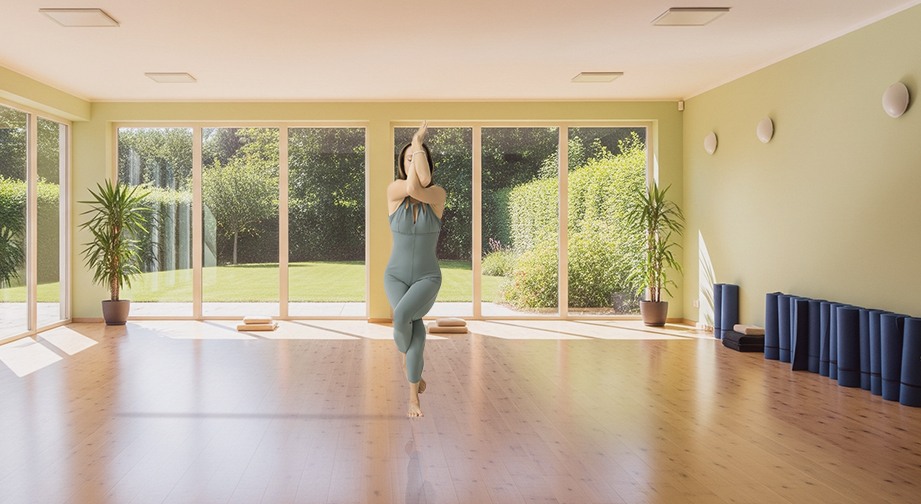Garudasana (Eagle Pose) – Step-by-Step Guide, Benefits, Tips, and More
Introduction
Garudasana, or Eagle Pose, is a classic standing balancing asana in yoga practice. In Sanskrit, Garuda means "eagle" (the mythical bird and vehicle of Lord Vishnu), and asana means "pose" or "posture". The essence of Garudasana is balance, focus, and release.
If you’ve ever felt stiff shoulders or hips after sitting at your desk for hours, Garudasana is truly your best friend! This pose wrings out tension, challenges your balance, and brings both body and mind back into the present moment.
Step-by-Step Guide: How to Do Garudasana (Eagle Pose)

- Start in Tadasana (Mountain Pose):
Stand tall, feet together, arms at sides, grounding evenly through both feet.
- Bend Your Knees Slightly:
Imagine you’re about to sit into a very high chair.
- Cross Your Right Thigh Over the Left:
Shift weight into the left foot, lift your right leg, and cross it tightly over the left. If possible, hook your right foot behind your left calf (okay if it doesn't reach!).
- Swing Your Arms:
- Bring your arms straight out in front of you, parallel to the floor.
- Cross your left arm over your right at the elbows.
- Bend your elbows and bring the backs of your hands together, or wrap the forearms to bring the palms together (like two intertwined eagle wings).
- LIFT & ALIGN:
Lift elbows to shoulder height, fingertips reaching upward, shoulders relaxing downward.
- Focus & Breathe:
Gaze softly at a fixed point in front of you, steady your breath.
- Inhale: Lengthen the spine, lift through your arms.
- Exhale: Sink a little deeper into the bend, draw the belly gently in.
- Hold the Pose:
Stay for 3–5 slow breaths (about 20–30 seconds), then unwind and repeat on the other side.
Modifications for Beginners
- If your foot doesn’t hook, rest the toes on the mat for balance.
- If crossing the arms fully is uncomfortable, just hug opposite shoulders or bring backs of hands together.
- Use a wall for balance if needed (stand sideways and use fingertips).
Intensifications for Advanced Practitioners
- Squat deeper to intensify the pose and build strength.
- Press the forearms up and away from your face, maintaining alignment.
- Close your eyes for a deeper balance challenge (only if you feel steady).
Alignment & Safety Tips
- Key Alignment:
- Knees and elbows should point in the same direction—centered.
- Sit hips straight back, not twisting to either side.
- Keep your spine long; chest lifted, shoulders down.
- Common Mistakes:
- Hunching shoulders to ears—keep shoulders relaxed.
- Knee or ankle twisting—align knees; never force the wrap.
- Safety Precautions:
- Avoid if you have recent knee, ankle, or shoulder injuries.
- Pregnant practitioners or those with balance issues can use a wall for support or skip the leg wrap.
Benefits of Garudasana (Eagle Pose)
Physical Benefits
- Strengthens thighs, calves, ankles, and core
- Improves hip, knee, and shoulder flexibility
- Elongates and relaxes shoulders and upper back
- Enhances balance and postural awareness
Mental Benefits
- Increases focus and concentration
- Relieves mental stress and tension
- Brings a gentle sense of calm and mindfulness
Energy / Chakra Connection
- Stimulates the Ajna (Third Eye) and Anahata (Heart) chakras
- Opens energetic channels in the shoulders and hips
Contraindications
- Avoid Garudasana if you have:
- Knee, ankle, or shoulder injuries
- Severe balance issues or vertigo
- Late-term pregnancy (try a gentle arm variation instead)
- Safe Alternatives:
- Do the pose seated (chair Garudasana)
- Practice only the arms or legs separately
Beginner’s Tips & Variations
- Use Props: Hold a block between your thighs to activate the inner legs; use a wall for balance.
- Gentle Variation: Skip the foot hook; keep toes on the floor.
- Advanced Variation: Fold forward from the hips while balancing, or close the eyes.
How to Include Garudasana in a Yoga Flow
Garudasana works well as a main practice or as part of a balancing sequence, helping to build heat and focus.
- Precede with: Warrior II, Chair Pose, or Standing Forward Fold
- Follow with: Tree Pose, Dancer Pose, or Seated Spinal Twist
Mind-Body Connection
When practicing Eagle Pose, invite your mind to focus completely on your breath and sensation—notice the subtle shifts in balance, the stretch through your shoulders and hips, and the feeling of energy wrapping around your body. Garudasana is traditionally associated with clearing mental fog and aligning your mind’s focus (third eye chakra), making it a wonderful posture to cultivate presence and clarity.
Summary Box
- Asana Name: Eagle Pose (Garudasana)
- Level: Beginner to Intermediate
- Focus Areas: Legs, Glutes, Core, Shoulders, Hips
- Duration: 3–5 breaths each side
- Best Time to Practice: Morning or evening, before seated postures
FAQs on Garudasana (Eagle Pose)
Is Garudasana safe for beginners?
Yes! Use modifications and props for support. Start with the arms or legs only, if needed.
How often should I practice Eagle Pose?
Aim for 2–4 times per week. It pairs well with most standing sequences.
What if I can’t hook my foot or bring palms together?
No problem! Rest the toes on the mat, and just press backs of hands together. With practice, flexibility and balance will improve.
Can Eagle Pose help with shoulder tightness?
Absolutely! The arm and shoulder wrap deeply stretches the upper back and shoulders.